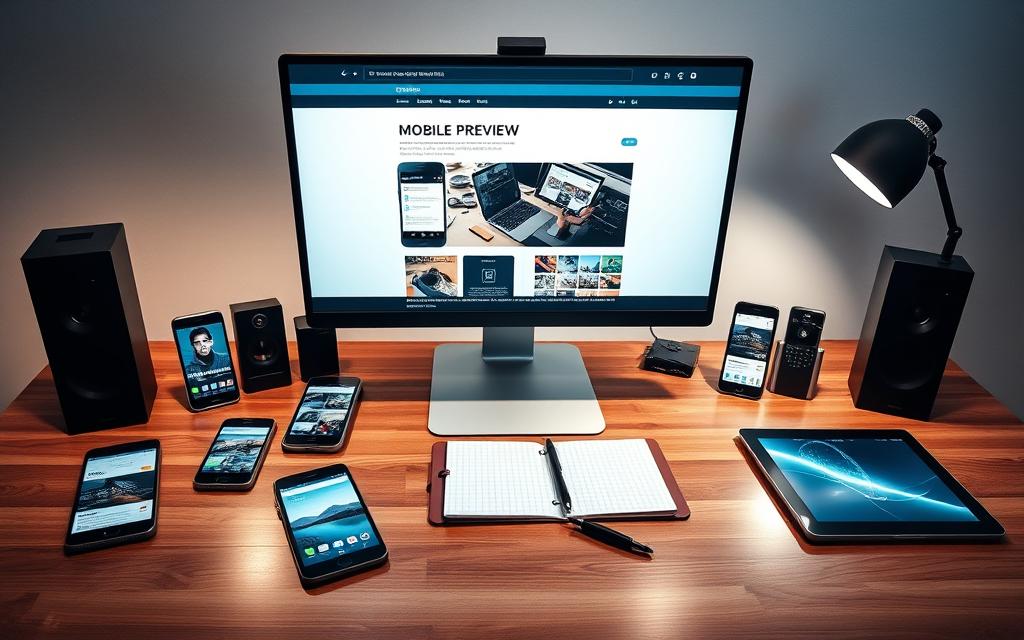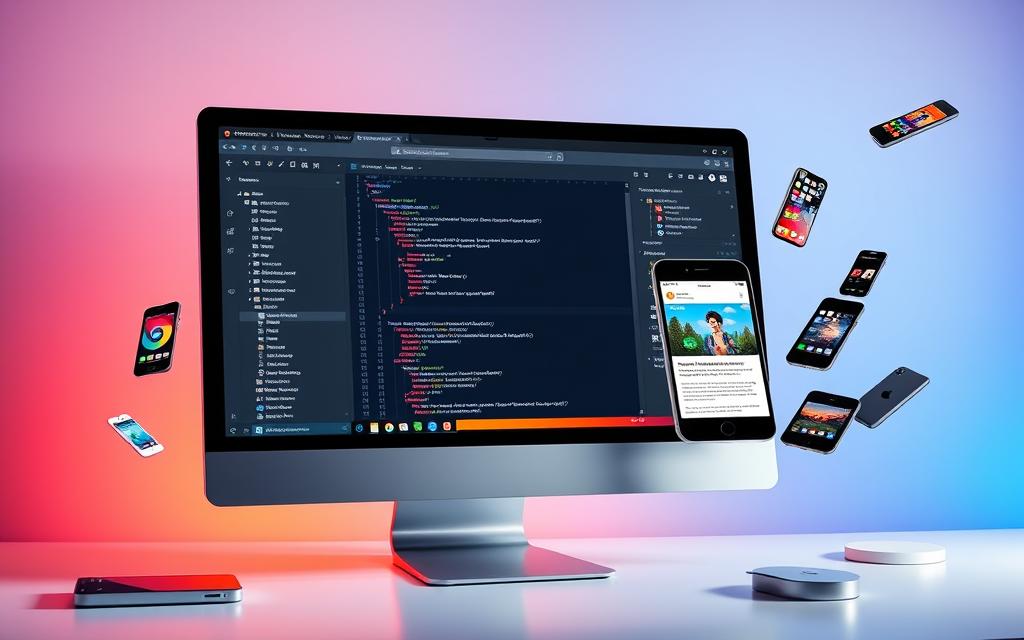Table of Contents
In today’s world, knowing how to show a mobile site on a PC is crucial. This is important for both developers and regular users. More than half of all web traffic now comes from mobile devices. So, having a website that looks good on mobiles is key for its success.
Google Chrome is the top mobile browser with a 65.12% market share. It has special tools for viewing mobile websites, known as Chrome DevTools. This article will look at two important ways to see mobile sites on a PC. You can use Chrome’s features or BrowserStack Live. BrowserStack Live lets you test on over 3,500 real devices to make sure everything works perfectly.
Introduction to Mobile Website Viewing
More people now browse the web on smartphones, leading to a significant shift towards mobile-centric browsing. This change shows the growing importance of mobile optimization. Responsive design is key for adapting websites to mobile, improving both web development and user experience.
Designers work to ensure websites perform well on all screen sizes. Tools in browsers like Google Chrome, Safari, Firefox, and Microsoft Edge help. They let users see how websites look on mobile devices. This is vital for testing and perfecting mobile site design.
WordPress integrates features for mobile preview during content editing. It gives visual feedback for both smartphones and tablets. Checking how links, assets, and menus work on mobile is crucial. These factors greatly affect user engagement and satisfaction.
Mobile-friendly websites are now more important for good SEO rankings, as recent stats show. Using tools like emulators and developer options helps businesses stay ahead. To learn more about making websites mobile-friendly, check out these detailed recommendations.
https://www.youtube.com/watch?v=fh4hO29Lt9Y
Importance of Testing Mobile Versions
Testing mobile sites is key in today’s online world. The rise of smartphone use changes how we browse the web. Now, people look at their phones 58 times a day, and by 2026, we’ll have about 7.5 billion smartphone users worldwide. This trend shows why site compatibility on various devices is crucial for a good user experience.
Thanks to responsive design, websites now work better on mobiles. No more annoying scrolling just to read a page. Stats tell us that millennials are on their phones for over 5.7 hours each day. So, a site that looks good on any screen means happier visitors. They’re less likely to give up on an app or leave a website out of annoyance.
Studies reveal that 80% of folks will remove apps that don’t meet their needs. And half do so if an app uses too much space. Also, 48% will leave a website that loads too slowly. This makes testing for mobile so vital. It ensures sites work well and meet user expectations.

With over 9000 different mobile devices used today, testing for site compatibility is a must. It boosts how people see your brand and their overall happiness. Following the best practices in mobile testing is key for keeping users and showing that you care about quality.
| Statistic | Importance |
|---|---|
| 58 times | Average daily phone checks |
| 7.5 billion | Projected global smartphone users by 2026 |
| 3 hours 15 minutes | Average daily smartphone usage |
| 80% | Users who delete apps that underperform |
| 48% | Rate of app abandonment due to slow performance |
Testing mobile versions is really important for keeping users happy and engaged. As digital tech keeps evolving, ensuring your site works on mobile is foundational.
Understanding Chrome DevTools
Chrome DevTools is a crucial set of web development tools in the Chrome browser. It lets developers test and fix websites with ease. You can open DevTools by right-clicking on a webpage and selecting “Inspect.” This feature is key for mobile simulation, as it lets you mimic different mobile devices.
Today, over half of internet users browse on mobile devices. So, making websites mobile-friendly is vital. Mobile sites are usually quicker to load than desktop versions. They have simpler designs and fewer graphics. Chrome DevTools is fantastic for making sure websites work well on all devices.
The Device Toggle Toolbar in DevTools is super handy. It provides a simple way to swap between mobile device views. This lets developers see how sites look on various screens. It improves cross-device compatibility when designing.
Chrome DevTools also offers short videos and articles. These resources teach about different features, including simulating devices and tweaking webpage designs with the Document Object Model (DOM) or Cascading Style Sheets (CSS). This information is great for getting to grips with mobile simulation.
Using Chrome DevTools helps spot common issues with mobile websites, like pages that don’t load right or elements that don’t work. Fixing these issues makes browsing smoother. This leads to happier users.
| Feature | Functionality |
|---|---|
| Device Toggle Toolbar | Emulates various mobile devices for testing responsiveness |
| Command Menu | Allows running commands, opening files, and more |
| Resource Library | Includes articles and videos for further learning |
| Debugging Tools | Inspects, modifies, and debugs web applications |
| Simulation Articles | Guides on building mobile-first websites |
How to View Mobile Site on PC
Testing how websites look on mobile devices is now key for developers. There are two main ways to do this: using Chrome DevTools or BrowserStack Live. Each method has its benefits and lets you view mobile site on PC easily.
Method 1: Using Chrome DevTools for Mobile View
Chrome DevTools is part of the Chrome browser. It lets users see a mobile view easily. Just follow these steps:
- Open the website you want in Chrome.
- Right-click anywhere on the page and pick “Inspect”.
- Hit the device toggle icon for mobile view.
- Pick your device from the list.
- Refresh to see the page in mobile layout.
This way, you can test on various screen sizes fast. But, it’s not perfect. It can’t mimic all features of each device’s hardware or system. Many turn to extensions like Mobile View Switcher Lite too. It’s popular, with 100,000 users and a 3.5 rating.
Method 2: Employing BrowserStack Live
BrowserStack Live is for testing on real devices via the cloud. It has over 9,000 devices. So, it shows how sites truly perform. Its advantages include:
- Tests across different systems and networks.
- Brings 100% right results for developers.
- Avoids issues with emulators and simulators.
BrowserStack Live makes test outcomes reliable. It uses real gadgets, so there’s no guessing about mobile site experiences. For serious testing, it’s the top pick.
| Feature | Chrome DevTools | BrowserStack Live |
|---|---|---|
| Device Profiles | Limited to chosen profiles | Over 9,000 real devices accessible |
| Testing Accuracy | May miss some hardware details | Spot on with real device tests |
| Network Condition Simulation | Not on offer | Supports varied network settings |
| User Traffic Simulation | Can’t do it | Possible to test |
| Setup Complexity | Simple to start | Needs a subscription |
Comparing them, Chrome DevTools is quick and easy for viewing mobile site on PC. But for deep and exact testing, BrowserStack Live is essential for developers.
Comparing Simulators and Real Device Testing
The choice between simulators and real device testing massively impacts web testing outcomes. Simulators, such as Chrome DevTools, offer a cost-effective way for the early software development stages. They speed up deployment and are great for initial code work, thanks to better debugging tools. They quickly mimic software actions, making them ideal for startups and small companies. But, relying only on simulators has its drawbacks.
Real devices provide a clear benefit by showing true hardware and software interactions. This method is reliable, giving a full view of real-world usage, which is crucial for the last tests. Issues like battery life, interrupts, and touch responses need real devices for accurate testing. Emulators and simulators just can’t match this level of detail.
The pros and cons of simulators versus real device testing can be outlined as:
| Factor | Simulators | Real Devices |
|---|---|---|
| Cost | Lower maintenance costs | Higher initial and maintenance costs |
| Deployment Speed | Faster provisioning | Slower due to physical setups |
| Accuracy | Limited to software behaviour | Provides authentic interactions |
| Testing Scenarios | Easier parallel testing | Suitable for complete functionality, integrations, and real-world testing |
Using both methods together forms a strong strategy, ensuring apps work well on all platforms. For a deeper look into this subject, check out simulators vs real device testing. This guide showcases how to use both approaches effectively.
Common Errors When Viewing Mobile Versions
When trying to view websites on PCs, users often face common errors. These include slow loading pages and unresponsive features. Such issues can make the browsing experience less enjoyable. Visibility problems can also occur, leading to frustration and users leaving the site.
To fix these mobile website issues, certain steps can help. Simply refreshing the browser might sort out many problems. Clearing cached data can prevent old content from showing. It’s also key to keep the browser updated for the best performance on mobile sites.
Sometimes, formatting on mobile can be off. Google recommends using a viewport meta tag for mobile screens. And following their advice on button sizes and font dimensions improves usability.
Using Google PageSpeed Insights can pinpoint what slows a site down. It looks for issues like uncompressed images or too much JavaScript. By understanding and fixing these, users can enjoy browsing mobile sites way more.
Conclusion
Today, nearly half of all web page views come from mobile devices. This shows how important mobile viewing is in web development. Tools like Chrome’s Device Mode and BrowserStack Live help developers test their sites on different devices. By doing so, they make sure websites work well on any screen.
Testing and improving for mobile viewing boosts user experience and keeps users interested. As more people use mobiles for browsing, developers must focus on this trend. Chrome’s Device Mode offers features like custom viewport sizes and throttling. These are key for creating strong websites.
Using cross-browser testing tools saves time and ensures websites run smoothly on various browsers. A commitment to responsive design results in web apps that work seamlessly across devices. Looking ahead, web development will clearly need to prioritize mobile usability to meet changing user needs and business goals.
FAQ
What is mobile website viewing?
Mobile website viewing lets you see websites on a mobile device. It’s key for making web browsing mobile-friendly. This improves how websites are built and how users experience them.
Why is testing mobile versions important?
Testing mobile versions is critical. It makes sure websites work well on various devices and screens. Good testing increases user happiness and helps your site’s reputation and search rankings.
How can I access Chrome DevTools?
Access Chrome DevTools in Google Chrome by right-clicking a webpage and choosing “Inspect”. Or, press Ctrl + Shift + I. This tool has many features for mobile simulation, like the Device Toggle Toolbar.
What are the advantages of using BrowserStack Live?
BrowserStack Live is a cloud testing service with access to many real devices. It lets you test on different systems and under various network conditions. It gives a real insight into user experiences.
What’s the difference between simulators and real device testing?
Simulators, including Chrome DevTools, give a quick view but can miss certain hardware and conditions. Testing on real devices, like with BrowserStack Live, gives a thorough check. It ensures sites work across all platforms.
What common errors might occur while viewing mobile versions?
Errors can include pages that load poorly, elements that don’t respond, and inconsistent visibility. Solving these problems might mean refreshing the browser, clearing the cache, or updating the browser. This helps make mobile sites better.
How does responsive design enhance mobile website viewing?
Responsive design makes websites work well on all screen sizes. It improves how users interact with sites and ensures a good experience on any device. Being adaptable is essential in today’s mobile-focused world.









